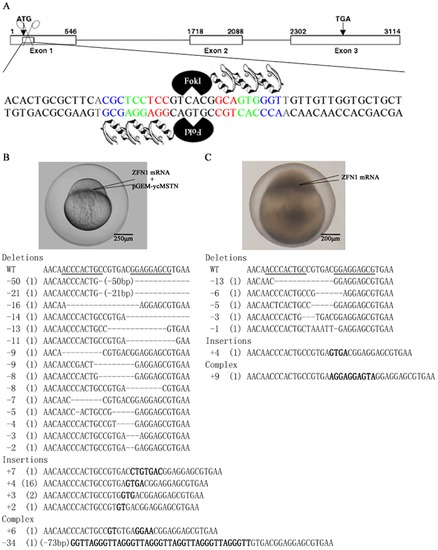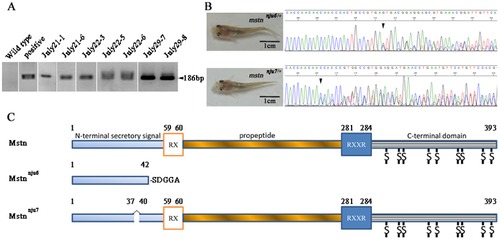- Title
-
Heritable Targeted Inactivation of Myostatin Gene in Yellow Catfish (Pelteobagrus fulvidraco) Using Engineered Zinc Finger Nucleases
- Authors
- Dong, Z., Ge, J., Li, K., Xu, Z., Liang, D., Li, J., Li, J., Jia, W., Li, Y., Dong, X., Cao, S., Wang, X., Pan, J., and Zhao, Q.
- Source
- Full text @ PLoS One
|
Zebrafish embryos can be used as an in vivo system to examine ZFN activity of editing yellow catfish mstn gene. (A) Schematic diagram shows ZFN1 binding to the yellow catfish mstn gene. Yellow catfish mstn exons are shown as boxes and its introns are shown as solid lines. Start codon (ATG) and stop codon (TGA) are marked in exon 1 and exon 3, respectively. Number above the exon box denotes the position of nucleotides in the gene [4]. The ZFN1 binding site is in exon 1. The triplets of nucleotides recognized by ZFN1 fingers are marked in different colors. (B) Zebrafish embryos were used as an in vivo system to examine ZFN activity of editing yellow catfish mstn gene. The plasmid containing exon 1 of yellow catfish mstn gene (pGEM-ycMSTN) was co-microinjected with ZFN1 mRNA into zebrafish embryos at 1–2-cell stage. The mstn molecules were amplified from the zebrafish embryos at 24 hpf and then subcloned for sequencing. Analyses on sequences of the molecules revealed that the molecules of disrupted mstn were categorized into three groups including deletions, insertions and complex. (C) ZFN1 cut mstn in yellow catfish genome. ZFN1 mRNA was microinjected into yellow catfish embryos at 1–2-cell stage. The mstn molecules were amplified from the yellow catfish embryos at 72 hpf and then subcloned for sequencing. Analyses on sequences of the molecules revealed that the molecules of disrupted mstn in yellow catfish genome were categorized into three groups including deletions, insertion and complex. WT: partial sequence of wild type mstn containing ZFN1 targeting site (B, C). Number in the leftmost of the panels (B, C) shows the number of nucleotides was deleted (-) or inserted (+) in the mutated mstn gene. Number in the bracket shows the frequency of the mutated molecules (B, C). Inserted nucleotides are bolded (B, C). |
|
Generation of mstn knockout yellow catfish using engineered zinc finger nucleases. (A) 7 yellow catfish founders were identified to potentially carry mutated mstn in their germ cells by PCR. Agarose gel electrophoresis revealed that embryos from 7 yellow catfish founders gave out a predicted 186 bp product. The results suggested these fish carried a mutated mstn with the 4 bp insertion in their germ cells. “Wild type” and “Positive” denote the templates used for the 1st round PCR were the genomic DNA isolated from a wild type yellow catfish (negative control) or the mutated mstn molecules with the 4 bp insertion (positive control), respectively. “July21-1, July21-6, July22-3, July22-5, July22-6, July29-7 and July29-8” denote the templates used for the 1st PCR were the genomic DNA isolated from the different founders, respectively. (B) Sequencing chromatography shows the PCR products from two juvenile yellow catfish containing different mutated mstn alleles in their genomes. Arrow heads indicate that the mutated mstn alleles have different sequences from wild type allele stating from the base pointed. (C) Schematic diagram shows two mutated proteins would be produced from the two different strains of yellow catfish carrying different mutated mstn alleles. Mstn: Yellow catfish wild type Mstn comprises a signal sequence (N-terminal secretory signal), a propeptide domain (propeptide) and a bioactive domain (C-terminal domain). RX is a proteolytic site to remove the signal sequence and RXXR is a proteolytic processing site (RSSR) to produce bioactive form of Mstn. The number shows the position of amino acid residue [4]. Mstnnju6: A truncated protein encoded by mstnnju6 contains only the 42 amino acid residues of the N-terminal secretory signal of yellow catfish Mstn plus 5 new amino acid residues. Mstnnju7: A mutated protein encoded by mstnnju7 lacks two amino acid residues between aa37 and aa40 in the N-terminal secretory signal of yellow catfish Mstn. |


